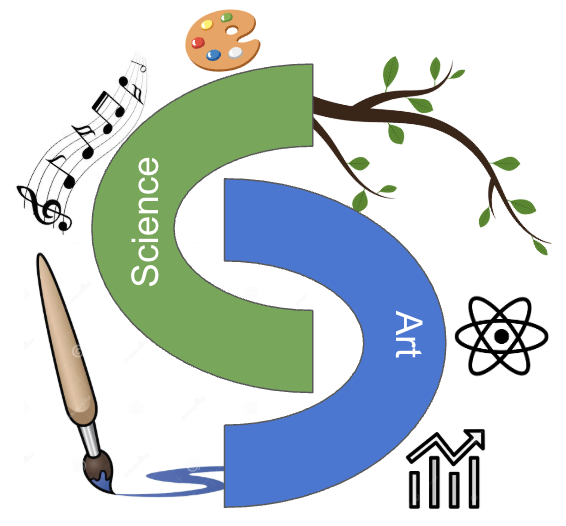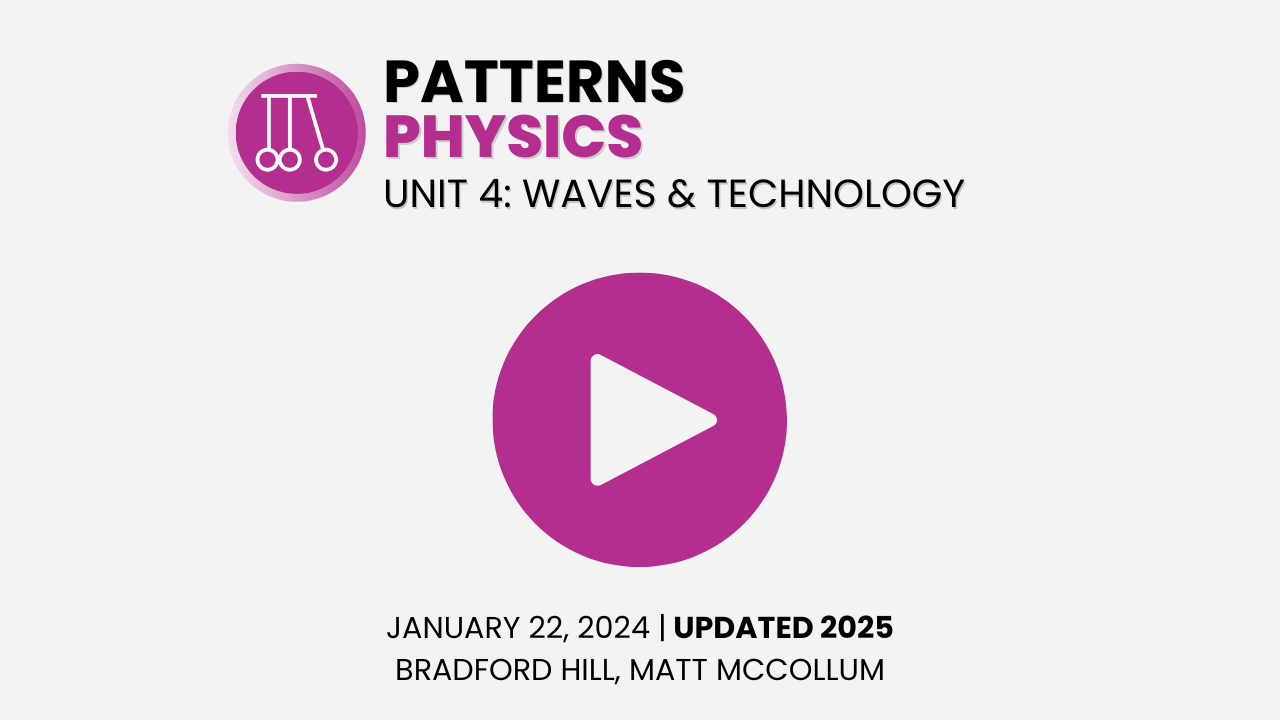
Unit 4: Waves and Technology
How are you hearing me?
About
Unit 4 Contents
A. Unit Resources
B. Unit Information
C. Standards & Practices
D. Task Sets
4.1 - Waves and Technology
4.2 - Investigating Waves
4.3 - Ultrasound
4.4 - Cell Phones
4.5 - The Ear
4.6 - Encoding and Decoding
4.7 - Sending a Signal
Unit Outcome
This unit aims to synthesize and elevate students' reading, coding, and writing skills through a three-dimensional learning progression that focuses on the big ideas waves and technology.
Anchoring Phenomenon
This storyline’s anchoring phenomenon is an instigating cell phone call that raises the question “How are you hearing me?”.
Essential Question
How are you hearing me?
Unit 4 Webinar
Unit 4 Webinar Agenda
The Unit 4 Planner Google Doc can be accessed using the link above. This planner contains links to all lessons, lesson materials, and teacher notes.
Unit Summary
The phenomenon that launches this unit is a cell phone call to a student in the class, where the caller on speaker phone asks “How are you hearing me?”. Over the course of the unit, students discover the patterns with waves. Then use that understanding to explain ultrasound medical imaging technology and ultimately how cell phones work. Cell phone communication is operationalized by the engineering challenge of communicating a three letter signal by first coding a spreadsheet to digitize the signal in binary (ASCII), then transmit the digital signal using light and sound (AM and FM), then receive and decode the signal to complete the communication. This project models the sending and receiving of a text message.
How is the Unit Structured?
Unit 4 contains 7 task sets which will take approximately 7 weeks to complete. Essential Questions and Phenomenon for the six learning tasks are discussed in the overview videos for Unit 4 Full Video (12:57 minutes) (ad-free version) and Shorter Video (6:33 minutes) (ad-free version)
An Arts Integration lesson can be found in this unit.
Unit Resources
Open Access Unit 4
This Google folder (English) - houses all documents for this unit that have been updated.
This Google spreadsheet (Spanish) - houses some of the documents for this unit that have been translated into Spanish. We are beginning the process of translating all current student-facing Physics resources into Spanish.
This student calendar can be shared with your students. It is an abbreviated version of the teacher calendar with all the resources that students will need to do the unit.
Unit 4 Student Packet Google Link
Career Connected Learning
Oregon Health & Science University’s Kristi Tonning relates her work in high energy gamma waves to treat cancer to physics students lessons on the different frequencies electromagnetic radiation have when absorbed by matter. She specifically mentions the importance of collaboration and communication in working with her Radiation Therapy team and colleagues from a wide range of careers and backgrounds. The integration of technology and patient care. Waves Treatment at OHSU - High School Physics Career Connections - Therapy
Zachary Wilkinson from Oregon Health & Science University helps physics students connect their work in waves and technology to its hands-on application in cardiac sonography. Zach’s team uses ultrasound waves to produce scans of the heart to help doctors diagnosis potential complications. His path to this career combines his interest in photography with his desire to help others. Waves to Diagnose at OHSU - High School Physics Career Connections - Sonography
Vocabulary List
Coming soon
Tests, Quizzes, Rubrics and Keys
These are restricted documents. Restricted-access materials are for teachers only. You must request access. To request access to the restricted folder, please fill out this linked Google form
Unit Information
-
The following are example options to extend parts of the unit to deepen students’ understanding of science ideas:
Task Set 1 - Waves and Technology
Task Set 2 - Investigating Waves
Task Set 3 - Ultrasound
5LactivityExtension - For an added challenge, start with a new sheet wherein students must make everything, new skills include rotating text and merging cells.
Task Set 4- Cell Phones
Task Set 5- The Ear
Task Set 6 - Encoding & Decoding
Iterate the code in a creative way
Task Set 7- Sending a Signal
-
These formative assessments may require that the teacher have access to restricted files. To request access please fill out this linked Google form
Task Set 2 - Investigating Waves
Task Set 3 - Ultrasound
Check-in activity: Explain the basic Physics of Ultrasound Medical Imaging in Packet.
5Q2 - Quiz on the Basics of Ultrasound with this embedded Starting File for Coding (Key)
Task Set 4- Cell Phones
This assessment is meant to be done in the “Zone of Proximal Development” style – that is, it is done with teacher guidance: “Science Task: Evaluating Sources for Do Cell Phones Cause Cancer” (unlike other assessment files this is unrestricted so students can make a copy of this Doc)
Task Set 5- The Ear
Task Set 6 - Encoding & Decoding
Task Set 7- Sending a Signal
-
These assessments require that the teacher have access to restricted files. To request access please fill out this linked Google form.
HS-PS4-1: Use mathematical representations to support a claim regarding relationships among the frequency, wavelength, and speed of waves traveling in various media.
HS-PS4-2: Evaluate questions about the advantages of using a digital transmission and storage of information.
HS-PS4-4: Evaluate the validity and reliability of claims in published materials of the effects that different frequencies of electromagnetic radiation have when absorbed by matter.
This assessment is meant to be done in the “Zone of Proximal Development” style – that is, it is done with teacher guidance: “Science Task: Evaluating Sources for Do Cell Phones Cause Cancer” (unlike other assessment files this is unrestricted so students can make a copy of this Doc)
HS-PS4-5: Communicate technical information about how some technological devices use the principles of wave behavior and wave interactions with matter to transmit and capture information and energy.
Standards & Practices
-
HS-PS4-1: Use mathematical representations to support a claim regarding relationships among the frequency, wavelength, and speed of waves traveling in various media. . [Clarification Statement: Examples of data could include electromagnetic radiation traveling in a vacuum and glass, sound waves traveling through air and water, and seismic waves traveling through the Earth.] [Assessment Boundary: Assessment is limited to algebraic relationships and describing those relationships qualitatively.]
HS-PS4-2: Evaluate questions about the advantages of using a digital transmission and storage of information. [Clarification Statement: Examples of advantages could include that digital information is stable because it can be stored reliably in computer memory, transferred easily, and copied and shared rapidly. Disadvantages could include issues of easy deletion, security, and theft.]
HS-PS4-4: Evaluate the validity and reliability of claims in published materials of the effects that different frequencies of electromagnetic radiation have when absorbed by matter.[Clarification Statement: Emphasis is on the idea that photons associated with different frequencies of light have different energies, and the damage to living tissue from electromagnetic radiation depends on the energy of the radiation. Examples of published materials could include trade books, magazines, web resources, videos, and other passages that may reflect bias.] [Assessment Boundary: Assessment is limited to qualitative descriptions.]
HS-PS4-5: Communicate technical information about how some technological devices use the principles of wave behavior and wave interactions with matter to transmit and capture information and energy. * [Clarification Statement: Examples could include solar cells capturing light and converting it to electricity; medical imaging; and communications technology.] [Assessment Boundary: Assessments are limited to qualitative information. Assessments do not include band theory.]
-
This unit focuses on these Disciplinary Core Ideas
This unit focuses on these Disciplinary Core Ideas
PS3.D: Energy in Chemical Processes
Solar cells are human-made devices that likewise capture the sun’s energy and produce electrical energy. (secondary)
PS4.A: Wave Properties
The wavelength and frequency of a wave are related to one another by the speed of travel of the wave, which depends on the type of wave and the medium through which it is passing.
Information can be digitized (e.g., a picture stored as the values of an array of pixels); in this form, it can be stored reliably in computer memory and sent over long distances as a series of wave pulses.
PS4.B: Electromagnetic Radiation
When light or longer wavelength electromagnetic radiation is absorbed in matter, it is generally converted into thermal energy (heat). Shorter wavelength electromagnetic radiation (ultraviolet, X-rays, gamma rays) can ionize atoms and cause damage to living cells.
Photoelectric materials emit electrons when they absorb light of a high-enough frequency
PS4.C: Information Technologies and Instrumentation
Multiple technologies based on the understanding of waves and their interactions with matter are part of everyday experiences in the modern world (e.g., medical imaging, communications, scanners) and in scientific research. They are essential tools for producing, transmitting, and capturing signals and for storing and interpreting the information contained in them.
-
This unit focuses on these Science and Engineering Practices
Asking Questions and Defining Problems Asking questions and defining problems in grades 9–12 builds from grades K–8 experiences and progresses to formulating, refining, and evaluating empirically testable questions and design problems using models and simulations.
Evaluate questions that challenge the premise(s) of an argument, the interpretation of a data set or the suitability of a design.
Using Mathematics and Computational Thinking Mathematical and computational thinking at the 9-12 level builds on K-8 and progresses to using algebraic thinking and analysis; a range of linear and nonlinear functions including trigonometric functions, exponentials and logarithms; and computational tools for statistical analysis to analyze, represent and model data. Simple computational simulations are created and used based on mathematical models of basic assumptions.
Use mathematical representations of phenomena or design solutions to describe and/or support claims and/or explanations.
Obtaining, Evaluating, and Communicating Information Obtaining, evaluating, and communicating information in 9–12 builds on K–8 and progresses to evaluating the validity and reliability of the claims, methods, and designs.
Evaluate the validity and reliability of multiple claims that appear in scientific and technical texts or media reports, verifying the data when possible.
Communicate technical information or ideas (e.g., about phenomena and/or the process of development and the design and performance of a proposed process or system) in multiple formats (including orally, graphically, textually, and mathematically).
-
This unit focuses on these Crosscutting Concepts
This unit focuses on these Crosscutting Concepts
Cause and Effect
Empirical evidence is required to differentiate between cause and correlation and make claims about specific causes and effects.
Cause and effect relationships can be suggested and predicted for complex natural and human-designed systems by examining what is known about smaller scale mechanisms within the system.
Systems can be designed to cause a desired effect.
Stability and Change
Systems can be designed for greater or lesser stability.
-
This unit focuses on these aspects of the Nature of Science (NOS)
Influence of Engineering, Technology, and Science on Society and the Natural World
Modern civilization depends on major technological systems.
Engineers continuously modify these technological systems by applying scientific knowledge and engineering design practices to increase benefits while decreasing costs and risks.
Interdependence of Science, Engineering, and Technology
Science and engineering complement each other in the cycle known as research and development (R&D)
Other Unit Resources
Patterns Physics Teacher Desmos Collection
0 General Files Folder - contains many resources that support Patterns Physics
ELP Standards
9-12.1 - construct meaning from oral presentations and literary and informational text through grade-appropriate listening, reading, and viewing
9-12.2 - participate in grade-appropriate oral and written exchanges of information, ideas, and analyses, responding to peer, audience, or reader comments and questions
9-12.4 - construct grade-appropriate oral and written claims and support them with reasoning and evidence
9-12.5 - conduct research and evaluate and communicate findings to answer questions or solve problems
9-12.6 - analyze and critique the arguments of others orally and in writing
9-12.10 - make accurate use of standard English to communicate in grade-appropriate speech and writing


